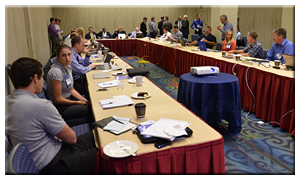| ASO Security Council Laser-Focused on Threats to ALPA Pilots
 August
5, 2014 - The security pillar of the Air Safety Organization
caucused on August 4, with a Security Council meeting
followed by presentations from TSA and Boeing and a panel
discussion on lessons learned during the laser awareness
campaign, a joint effort led by ALPA, the FAA, and the FBI. August
5, 2014 - The security pillar of the Air Safety Organization
caucused on August 4, with a Security Council meeting
followed by presentations from TSA and Boeing and a panel
discussion on lessons learned during the laser awareness
campaign, a joint effort led by ALPA, the FAA, and the FBI.
Darby LaJoye, deputy
assistant administrator for the Office of Security
Operations in TSA led the group through Government &
Regulatory Implications on the Crewmember. LaJoye spoke
briefly about the implications of TSA regulations on pilots,
including with KCM, then opened the floor to questions. Many
security representatives asked the TSA leader about the idea
of “risk-based security,” focusing on why TSA singled out
certain actions (by themselves or other pilots) in airports.
Faye Francy of The Boeing
Company discussed cyber security. Francy noted that the
airline industry is a huge global industry and thus a
potential target for attacks by hackers, phishers, and even
nation-states. “We have to understand this threat,” she
cautioned, “so we know how to recognize it.”
Francy is also a member of
the Aviation Information Sharing and Analysis Center (A-ISAC),
a recently created nonprofit partnership of airlines,
industry, and government (including ALPA). She said with
cyber attacks on the rise in the United States, aviation
needs a public/private partnership to develop a roadmap for
action. “This threat requires everyone working together,”
she emphasized, in order to fight the various attacks on the
way.
Capt. Robert Hamilton (PSA)
headed a panel discussion on “Laser Campaign—Lessons
Learned,” to discuss this year’s successful Laser Awareness
Campaign. He joined Laura Brown, deputy assistant
administrator for public affairs with FAA; George Johnson,
supervisory federal air marshal, Criminal Investigative
Division with the FBI; and Mollie Halpern, public affairs
specialist with the FBI. The panel described the positive
trend of laser attacks, pointing to a drop from roughly 11
incidents per day down to nine since the campaign began. The
group explained how the campaign moved from idea to test to
national campaign, and stressed that the partnership between
ALPA, the FAA, and the FBI led to a powerful, persuasive,
and successful campaign to fight laser attacks. Watch the
video and listen to the
radio ad.
Throughout the day the
recurring theme, as first brought up by Capt. Fred Eissler,
Aviation Security Chair, is the need for security to be more
proactive than reactive. And with that, the work of the
Security Council continues.
The Security Council
reelected Capt. Hamilton as the chair, and held a discussion
with attendees on security events that they’re seeing in
their day-to-day work, brainstorming ways to address them.
Eissler also introduced a
new motivational program for the group: “the challenge
coin.” These coins, embossed with ALPA’s logo, serve as a
form of recognition for special achievements. Eissler
presented the first coin of the day to Capt. Sean Cassidy to
acknowledge his continued efforts to enhance airline
security; the day’s presenters also received a challenge
coin as thanks. |